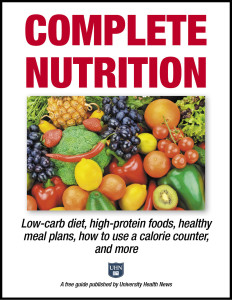Much Ado About Nitrates
Nitrates: we hear this word a lot, but it’s pretty difficult to get a straight definition of what nitrates really are or even if they’re good or bad.
The Centers for Disease Control and Prevention (CDC) explains that “nitrate is a compound that is formed naturally when nitrogen combines with oxygen or ozone… Nitrates are also made in large amounts by plants and animals and are released in smoke and industrial or automotive exhaust.”
In the medical world, nitrates are vasodilators, which relax arteries. Nitrates are used to treat illnesses like angina, hypertension, and congestive heart failure.
Eat Right, Starting Now!
Download this expert FREE guide, Complete Nutrition: Low-carb diet, high-protein foods, healthy meal plans, how to use a calorie counter, and more.
Create healthy meal plans and discover the Superfoods that can transform your plate into a passport to better health.
In the nutritional world, nitrates are natural ingredients in food that grows in the ground, like vegetables and fruits. Research shows consuming nitrates can be of great benefit to athletes—beet juice is a popular performance supplement—as nitrates intake improve muscle efficiency, which translates to increased strength and endurance. In one study, athletes drank about 17 ounces of beet juice per day for six days and did moderate- and high-intensity cycling. Compared to athletes who drank a placebo, those who drank beet juice had a lower demand for oxygen during moderate-intensity aerobic exercise and could exercise longer at a higher intensity before reaching exhaustion.
A 2016 Harvard study found that a greater intake of dietary nitrate and green leafy vegetables was associated with a 20 percent to 30 percent lower risk of primary open-angle glaucoma, according to a study published online by JAMA Ophthalmology.
Overdosing on Nitrates
The prominent symptom of nitrate poisoning is a blue skin color around the eyes and mouth (babies with methemoglobinemia were called “blue babies.”) Respiratory symptoms, headaches, and fatigue are often noticed. Methylene blue may be used as a treatment, as have oxygen chambers.
According to the CDC, nitrates we eat or drink usually aren’t harmful, although diarrhea and dehydration can make nitrates change to nitrites in greater amounts. Babies and people on untreated well water are at the highest risk. Pregnant women should also take caution.
Nitrates are also added to processed foods, like hot dogs, as preservatives. Foods with nitrates as an additive tend to look pink and taste a little salty. Look on the ingredients labels for the words “sodium nitrate” or “sodium nitrite” (more on nitrite below). Processed foods are often avoided because of cancer being associated with nitrates—or more specifically nitrites. However, the research behind that recommendation is widely disputed.
Chemically Speaking
Nitrates (NO3) are chemical compounds of nitrogen and oxygen. There are natural and synthetic nitrates. Nitrates on their own are harmless but essential to life. Our bodies can convert nitrates into nitric oxide (NO), which increases our blood’s oxygen-carrying capabilities and relaxes blood vessels, helping to lower blood pressure.
Nitrates can also be converted into nitrites (NO2). Some research has linked nitrites to carcinogen synthesis, aka cancer formation, although the conclusion is increasingly widely disputed.
In massive doses, nitrites also can cause methemoglobinemia, a serious blood disease most often found in babies that can reduce the oxygen levels in our cells. It’s important to note that methemoglobinemia can also be caused by anesthetics (benzocaine), nitrobenzene, and even some antibiotics.
Decades ago, methemoglobinemia was blamed on high nitrates levels in drinking water. However, in 1974, Congress passed the federal Safe Drinking Act, giving the U.S. Environmental Agency (EPA) the responsibility for setting drinking water standards for all states and eliminating any great concern (well water may still be a problem, however).
So, Where Are the Nitrates?
Nitrates occur naturally in foods grown in the ground. Vegetables high in nitrates include:
- Beets
- Cabbage
- Carrots
- Celery
- Collard greens
- Green beans
- Lettuce
- Parsley
- Radishes
- Spinach
Fruits are not high in nitrates as vegetables, but the higher levels of nitrates in fruits are in strawberries, currents, gooseberries, raspberries and cherries.
“Obviously, the nitrate content varies depending on soil composition,” reminds Livestrong.com. “So lettuce grown in California may differ greatly in nitrate content than lettuce grown in Mexico, for example.”
As for the nitrates found in processed foods, Prevention.com states that in the 1970s, “Researchers discovered that when meat containing sodium nitrite is heated above 266°F, it creates nitrosamines, or compounds that are carcinogenic to animals. That triggered the USDA to limit the amount of nitrites that may be added to cured meats and to require that all products containing nitrites include vitamin C, which prevents the formation of nitrosamines.”
But, before you become overly concerned, says Prevention.com, “For all the fuss that’s been made about nitrates, nitrites, and nitrosamines, cured meats only account for a minuscule 6% of our dietary nitrate intake. Around 80% of our nitrate consumption comes from veggies, according to the CDC (about 21% is accounted for by drinking water).”
Many dietary and medical experts have scaled back on any concerns over nitrate/nitrite consumption. A study looking at food sources of nitrates and nitrites, published by the American Journal of Clinical Nutrition, determined that, “The data considered here support the conclusions of the European Food Safety Authority that benefits of vegetable and fruit consumption outweigh any perceived risk of developing cancer from the consumption of nitrate and nitrite in these foods.”
In case you’re wondering, the acceptable daily intake (ADI) of nitrate, according to the World Health Organization, is 3.65 milligrams per kilogram of body weight per day (mg/kg/d).
The post Much Ado About Nitrates appeared first on University Health News.
Read Original Article: Much Ado About Nitrates »
Powered by WPeMatico


